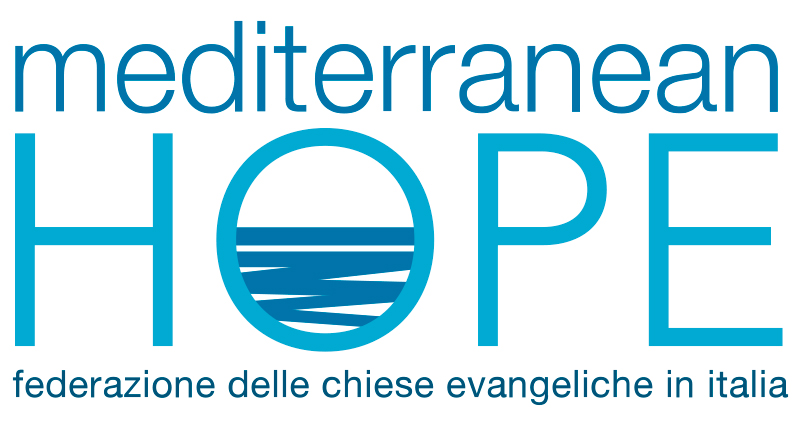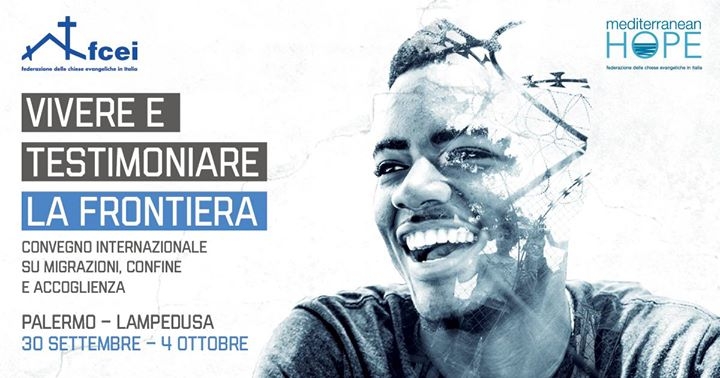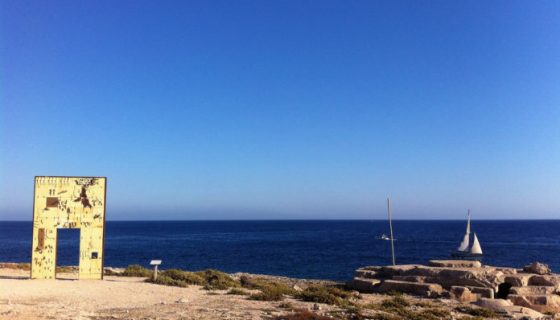- Mediterranean Hope - Federazione delle chiese evangeliche in Italia
- mh@fcei.it
Living and Witnessing the border. Final Conclusions
Paolo Naso – Political Scientist and Coordinator of the Mediterranean Hope – Project for Refugees and Migrants promoted by the FCEI.
At the end of a conference so full of analysis and contributions, it is difficult to draw conclusions that are not the repetition of what has already been so properly pointed out. Thus, I will just focus on some of the topics and be relating challenges that those who operate on the physical or mental “frontier” like us usually deal with. A frontier is a place that is by definitions full of people “different” by us that have asked to enter our territory.
For ease of reference, I will point out some of the issues we have discussed these days and for each of them, I will try to outline some possible work strategies. I will do these considerations by highlighting the contributions that have emerged these days and so by developing the many tales, proposals, and analysis shown.
- When discussing immigration flows, the first theme that seems to be imposing on us is that emotional and rational categories separate. I mean that one of the problems that we all face in Italy, such as in Europe or in the United States, is that the reason for immigration is less the criteria of rationality. This one should direct the confrontation and the public debate with the sole benefit of an emotional uncontrolled position unleashing prejudices and feelings that are not meditated or elaborate [Allievi and Dalla Zuanna]. Let’s take a few examples: we all know that the fall of the average birth rate condemns some countries to a quick aging of the population that imbalances the demographic pyramid: societies that age and who contract at the same time are condemned to the crisis of consumption, the collapse of the pension system and all impoverishment of social dynamics [Population Report 2007]. This is an obvious and immediately understandable reality that should suggest a useful approach toward immigration [Ambrosini 2010], especially because of these people average age and their highest birth. But for a complex psychological and social process, in the specific case of immigrants. The negative emotions triggered by the encounter with immigrants have shadowed the above “utility” criterion. This process also determines false perceptions of reality such as, for example, in Italy, which envisages a dramatic increase in immigrants, while – the facts suggest a stable foreign population that has approximately achieved five million people [Idos Confronti 2017: Livi Bacci, Calzolaio]. Not only. These are people with a higher working rate compared to the Italians and find work in specific sectors that are no longer interesting for nationals: in the macroscopic case of carers [Ambrosini 2013] we can add that of the agro-industry, heavy industry, constructions [Fondazione Moressa 2017 Report]. The question we must ask is how this “divorce” may occur from reasonableness and even from the utility criteria, and how such a perception may be altered to betray the substance of reality. The answer is intuitive and concerning Italy is strongly defined by the current narrative of the landings of refugees on the Sicilian coasts, presented as a massive, continuous, ungovernable, epochal flow. With a clear intent, refugees arriving on boats are confused with settled immigrants who contribute to the national economy by producing a GDP ratio of close to 9% [Fondazione Moressa 2017 Report]; above all, the language of the “massive invasion” is used in the face of figures that do not exceed 200,000 units and that, within the framework of a genuine European policy of solidarity and cooperation, it would be easy to absorb. But if the distortion of facts, numbers and dynamics is largely attributable to the dominant voices in the information system, the real question is to define who really benefits from this. The answer, also intuitive, to the xenophobic political enterprise that leverages the migration crisis in order to gather the consensus of the deprived popular class the mechanism is that of the “expiatory” immigrant [Naso] who is responsible for the crisis, urban degradation, resentment and competition of globalization [Rampini]. The political effect of such an “expiatory” immigrant paradigm is that only expulsion measures can restore cathartically the order and security that have been violated. It is a simplified and rude thesis, but looking at the European and North American scene is the “winning narrative”, the one that determines the tone of public debate [Manconi, Resta]. The only strategy of resistance and opposition to this paradigm is what was once called the counter-information removing, however, the end of every conceivable and rebellious value. In the mass communication society, counter-information must mean to provide rational and effective arguments, “truth” networks that deny the post-truth factory, tell migrants more about migration, giving them face to face and concreteness.
- We must realise that we are facing a new migration cycle requiring to update the analysis of the dynamics of global migration. The migratory system that Italy knew in the 1980s and 90s, with one or two decades of delay compared to other European countries, was based on the balance between push and pull factors, between emigration and attraction factors in some countries at an expanding stage of the labour market [Sassen]. Still talking about the Italian case is what we have experienced since the 1980s, in a decade that has literally reversed the direction of migration flows affecting Italy. More recently and to a large extent after 2011, the balance between push and pull factors broke and the ejection factors became the most prevalent. The ISIS attack, the crisis of Arab Spring, the failure of countries like Somalia and Libya, the ethnic, religious and civil conflicts in countries such as Nigeria or Mali, the violence of regimes like the Eritrean government have created an area of great instability in which large sections of the civilian population have lost elementary rights: from the availability of water to the freedom of expression of their religious faith, from protection to justice, from education to security. This scenario worsened by the economic factors that make the distinction between “asylum seekers” and “economic migrants” very difficult (we categorized them as “migrant 2.0” [Naso 2015]). Moreover, these economic factors have created a new complex migratory subject that is the sum of the two above categories, but it is not internationally recognized as a holder of asylum or international protection. On this matter, the rules date back to the Cold War. These rules have been conceived base on that geopolitical framework and cannot comprise the novelty and the gravity of the actual processes. New asylum policies should cover the ownership of international protection without limiting it to specific cases that have been often defined based on the simple national origin [Vassallo Paleologo]. Namely, there are Tunisian or Ghanaian citizens that are fully entitled to asylum but because of the application of the rules, these people are excluded from the protection since they come from countries for which we do not consider the persecution and risk under the Convention of Geneva. In such a scenario, what kind of proposal can we put in place? One proposal comes from what we have just said: reviewing and widening asylum and protection policies. But that is not enough. The geopolitical crisis that we have mentioned is too broad to believe that the migrations can be the only solution to deal with human rights violations and flee wars and environmental insecurity. In this perspective, it is appalling that the statement “Let’s help them in their own homes” has been underestimated by an instrumental and hypocritical political use. Thus today, this approach is, in fact, impracticable. Nevertheless, the topic of supporting policies of political stabilization and development arises with absolute urgency. Now those who have been calling for Let’s help them in their own homes intend to adopt anti-migration policies and, in practice, have launched an instrumental appeal that lacks conviction. Misleading advertising, we might say. However, the topic remains, and just who works for the reception has the duty to affirm it strongly: migration policies are also built with measures to be taken in the countries of origin. This will be a virtuous and complementary element if we think about remittances, to reduce expulsion factors. To deny the need for an “upstream” issue is a serious mistake that Europe or the United Nations could correct by putting together an overall plan to create a synergy between migratory policies, stabilization and cooperation interventions.
- Thirdly, the global migrations work in a system of communicating vessels. Blocking a way out proportionally increases the pressure on the other ones. Recent European measures can confirm this issue. As a matter of fact, the agreements with Turkey have blocked the Eastern route that brought migrants to Europe through the Balkan route. But, the primary effect of this choice was the increase of flows through the central route from Libya and the Sicilian ports, first of all in Lampedusa. Following the Italian agreements with various Libyan authorities, the central route seems to be temporarily interrupted by Libya, but against all expectations, flows from Tunisia have been resumed. It is still early to say what their nature is and whether it is a real flow or a marginal process and limited in time, but the fact remains that at least in the Mediterranean Sea system there is no “flow 0”. Assuming that perspective as a military and political goal is a serious and culpable illusion that ends up fuelling dramatic effects, such as migrant clandestine traffic, human trafficking, irregular and uncontrolled migrations. And as a primary effect, however, it causes a cancellation of fundamental rights [Vassallo – Cutitta]. The only real solution to illegal migration is the opening of legal and safe ways. This was the basic idea of the “humanitarian corridors” promoted by the FCEI (Federation of Protestant Churches in Italy) together with the Waldensian Board and the Community of Sant’Egidio (Sangiorgi, Rosso, Trotta, Del Bono]: an escape route for subjects potentially vulnerable that may be entitled to asylum or international protection by granting them an entry visa in Italy pursuant to Article 25 of the Schengen Agreement on Visas. The standard rule requires that, in order to benefit protection, one must first risk life by entrusting the traffickers. The process of humanitarian corridors bypasses this condition that infringes a fundamental right, by ensuring a sure and legal way to vulnerable people that are identified in specific categories such as victims of trafficking, persons who have suffered torture or persecution, individuals in need of urgent and life-preserving treatment s that are not available in the countries they currently find themselves, single women in vulnerable conditions, refugees evacuated by war scenarios. The Italian experiment, launched in 2015 after signing of a Memorandum of Understanding between the FCEI, the Waldensian Board, the Community of Sant’Egidio and the Ministries of the Interior and of the Foreign Affairs has allowed 1,000 refugees to have safe and legal access to Italy through a “humanitarian visa”. Once arrived in Italy, the beneficiaries immediately applied for asylum, confirming the quality of the preliminary screening work carried out by the project operators in Lebanon. So far, the request that has come to an end, has been 100% positive. As it is well known, the model was replicated by a second protocol signed by the Italian Bishops’ Conference, for another 500 visas from Ethiopia. In France, the request has been launched for 500 visas, in similar terms to the Italian ones. In Germany and in Switzerland, the proposal has been discussed with interest while various personalities – the President of the European Parliaments Tajani, the President of the Republic Mattarella, Pope Francis – have repeatedly and publicly expressed their support for this “good practice”. In just a few months, the Italian “humanitarian corridors” have relocated more people than the resettlement of the European Union have provided. We do not expect that Humanitarian Corridors could be the only solution to the migration issue but certainly, they show a model that Europe could adopt. Thousands of visas are a drop in the ocean, but in an immobile and indifferent Europe, they have been an injection of sustainability and hope. A small group of believers, an expression of civil society, has shown that “it is possible” and that, even in the narrow patterns of the current legislation, there are opportunities that need to be pursued and promoted. This has been and will be our commitment.
- The statement by Commission President Junker that “on migrants, Italy has saved Europe’s conscience” contains the implicit admission that Europe’s migrants have failed. Instead of looking for immigration policies and measures, several EU countries have begun building defensive walls and barriers, denying their support to Mare Nostrum, which with its search and rescue activities saved more than 100,000 people. By some cruel fate, the utopia of an open European space collided with the realism of the fear of immigration and so, just over twenty years after the last entries to the Schengen Area, the European issue is no longer the opening of borders but, on the contrary, their transformation into closed and impenetrable frontiers to migrants and asylum seekers. Paradoxically, in the age of globalization, the closed and militarised border is becoming a key to geopolitics [Graziano]. Looking at the next future, many people are prophesying that if this Europe is unable to solve this problem, it condemns itself to political and moral failure. We also think of ourselves but, unlike others, we want to say that if this happens, we will share such responsibility. Of course, none of us has an institutional role, and least of all so important to influence European policies. But, I do not believe that civil society can escape the failure of an inclusive and welcoming Europe idea. If in the end have prevailed what in a somewhat ideological language is called the “Europe of the Banks” this is also depended on the inability of European civil society – unions, associations, movements, churches, communities of faith … – to support another path. I mean that a new migration policy cannot be the fruit of another Europe, another culture of solidarity between countries and peoples who have decided to make a pact of unity.
Conclusion
This conference has been conceived and organized by churches, ecumenical associations, and believers who have spent these years to put in place the Gospel message. I do not need to remind the spiritual, biblical and theological reasons that have driven our commitment. I would just like to say a few words about the attitude, the “stance” that, in my view, we should pursue.
First of all, I would say an attitude of freedom. Freedom, to tell the truth, not to be conditioned by consortium actions or opportunities of the moment. It is with this attitude that from the beginning we have launched the Mediterranean Hope
– Project for Refugees and Migrants promoted by the FCEI., not by chance quoting Martin Luther King: Cowardice asks: is that safe? Opportunity asks: is that convenient? Complacency asks: is that popular? But conscience asks: is that right? Sooner or later it comes the time when we must take a position that is neither safe nor convenient or popular; but you must take it because it’s right. ”
A second attitude is what I would call “acceptance of vulnerability“. We work on a fluid matter with processes that are rapidly changing and require a continuous change of course. It is wrong to be fixed and useless to build large apparatus or it is risky to plan in the long run. Honestly, according to Bible every day its affection but with a design and a perspective in mind. Yet, with an attitude always open to the new and being inclined to change our working methods and goals.
The third, inevitable, word is that of “hope“. In an epoch in which we can see a wave that rejects immigrants and fears them as an economic, social, and even religious threat, we are evangelically bearing a “hope beyond hope”. Those who have experienced the “humanitarian corridors”, touched with this simple truth of faith. For instance, Falak a little blind girl, devastated by a disease that could certainly not be cured by living in a garage on the outskirts of Beirut, could recover her life. Today, Falak goes to school, speaks Italian and is a happy child because we have acted together and hoped beyond hope.
References
Allievi S., Dalla Zuanna G., Tutto quello che non vi hanno mai detto sull’immigrazione, Laterza 2016
Ambrosini, M., Richiesti e respinti. L’immigrazione in Italia. Come e perché, Saggiatore 2010
Ambrosini, M., Immigrazione irregolare e welfare invisibile. Il lavoro di cura attraverso le frontiere, Il Mulino 2013
Calzolaio, V., Pievani T., Libertà di migrare. Perché ci spostiamo da sempre ed è bene così, Einaudi 2016
Del Bono, D., Immigration will reveal the crisis of human rights inside our societies, Malmö University Electronic Publishing, 2017, online
Fondazione Leona Moressa, Rapporto annuale sull’economia dell’immigrazione, 2017 Graziano, M., Frontiere, Il Mulino, 2017
Livi Bacci, M., In cammino. Breve storia delle migrazioni, Il Mulino 2014
Manconi, L., Resta F., Non sono razzista ma…La xenofobia degli italiani e gli imprenditori politici della paura, Feltrinelli 2017
Naso P., Immigrato espiatorio, Aliberti 2010 Naso, P. Migrazioni 2.0, in Limes, n.6/2015
Rampini, F., Il tradimento. Globalizzazione e immigrazione, le menzogne delle élite, Mondadori 2016
Rapporto sulla popolazione. L’Italia all’inizio del XXI secoli, Il Mulino, 2007
Rosso, D., Responding to the Challenge. The Search for Hope in the Mediterranean, Diaconia: Volume 7, Issue 1/2016, pp. 68-74.
Sangiorgi, G., La via italiana dei “corridoi umanitari”, Libertà civili, gennaio febbraio 2017 Sassen, S., Una sociologia della globalizzazione. Einaudi, 2008
Trotta, S., Safe and Legal Passages to Europe:A Case Study of Faith-Based Humanitarian Corridors to Italy, University College London, online
Vassallo Paleologo, F., Diritti sotto sequestro. Dall’emergenza umanitaria allo stato di eccezione, Aracne 2010
Vassallo Paleologo, F., Cutitta P., Diritti sotto sequestro. Dall’emergenza umanitaria allo stato di eccezione, Edizioni scientifiche italiane, 2006





